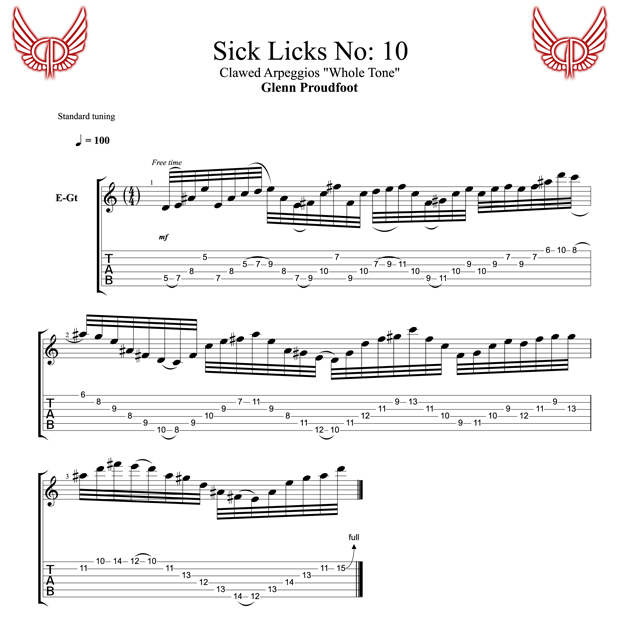Sick Licks: An Introduction to the "Claw Technique"

In this Sick Lick, I'm using the whole tone scale. You have to be careful with this scale when adapting it to rock, as tonally it is way outside what the listener would normally be used to -- so it's important not to get lost!
Make sure you are always mindful of where you are on the neck and that you are thinking about what other scales you can switch in and out of if you start to get too far outside the tonal core.
The technique I use in this Sick Lick is what I call the “claw technique." What I actually do is use my right-hand fingers to pluck the arpeggios, as a bluegrass guitarist would do when he's got the thumb-bass technique going.
This enables me to skip strings and create some different sounds and rhythmic ideas. It's a very cool technique and also can be adapted to melodic and chordal playing. This idea spawned from the fact that I played a lot of banjo as a kid.
I start this Sick Lick with a crazy arpeggio section. This is very tricky, due to the claw technique and the unique shape of the arpeggio. I find it's always great to experiment with things that aren't deemed traditional. It's not that I'm setting out to reinvent the wheel, but it's simply great fun to experiment and see what you can come up with!
The first arpeggio is a combination of hammers and string skipping with the claw technique. In order to get used to this technique, I would trill the first four notes of this arpeggio and get a flow going before moving on. Like I said, it's tricky, but like anything else, practice it slowly then build it up!
The second arpeggio is the same as the first; it's simply played up a tone.
All the latest guitar news, interviews, lessons, reviews, deals and more, direct to your inbox!
From here I move into some descending three-string arpeggios with the claw technique. Why do I use the claw technique in this section? Because I have more control over the rhythmic pattern of the run than I would if I just swept the pattern. It also enables me to play this section faster and cleaner than if I where sweeping.
The next section is with sweep picking, using a combination of five- and six-string arpeggios, which leads into another section of the claw technique. This is interesting: It's a descending three-string arpeggio section, but what I actually do here is play a descending run starting on the 11th fret of the A string. Then I actually move up the scale and start the next arpeggio on the 12th fret of the D string, which is also a descending run.
Sounds a little confusing, but it's actually easier done than said!
This is why I love the claw technique. You can move up and down the neck using three-string arpeggios and create really unique and crazy-sounding runs and arpeggios!
Thanks very much and I hope you enjoy!
Please feel free to join me on YouTube here.

Australia's Glenn Proudfoot has played and toured with major signed bands and artists in Europe and Australia, including progressive rockers Prazsky Vyber. Glenn released his first instrumental solo album, Lick Em, in 2010. It is available on iTunes and at glennproudfoot.com. Glenn was featured in the October 2010 issue of Guitar World and now creates "Betcha Can’t Play This" segments and lessons for GW. Glenn also has a monthly GW column, "Loud & Proud," which offers insight into his style and approach to the guitar. Glenn is working on a project with Ezekiel Ox (ex Mammal) and Lucius Borich (Cog), which is managed by Ted Gardner, ex-Tool and Jane's Addiction manager. The band has done pre-production on 22 tracks and is set to hit the studio and finish their first studio album. The album is set for release in 2012. Glenn also is working on the followup to his debut album; it, too, will be released in 2012.
